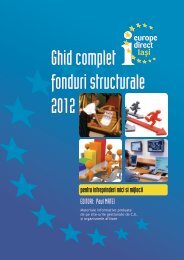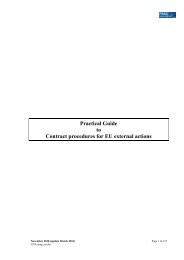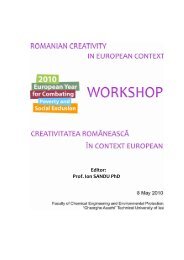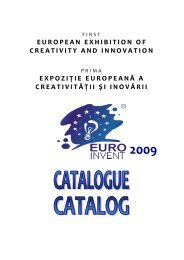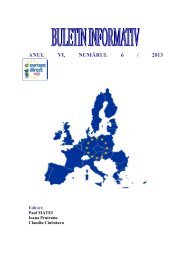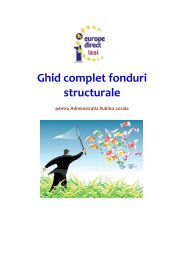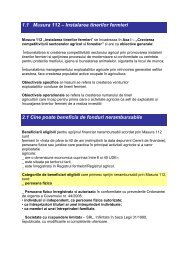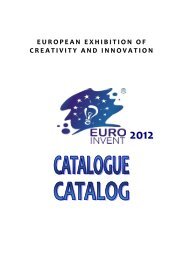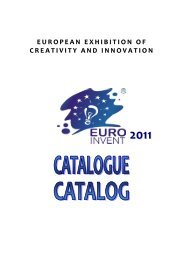eur op eanexhibitionofcreati vityandinnovation - Europe Direct Iasi
eur op eanexhibitionofcreati vityandinnovation - Europe Direct Iasi
eur op eanexhibitionofcreati vityandinnovation - Europe Direct Iasi
You also want an ePaper? Increase the reach of your titles
YUMPU automatically turns print PDFs into web optimized ePapers that Google loves.
EUROINVENT 2013<br />
Russian Federation<br />
10.1.<br />
Title<br />
Authors<br />
Institution<br />
Description EN<br />
Class no.<br />
Biological treatment of industrial wastewater<br />
containing zinc by Spirulina platensis<br />
I. Zinicovscaia 1,3 , L. Cepoi 2 , T. Chiriac 2 , Gh. Duca 3 ,<br />
T. Mitina 3 , M.V. Frontasyeva 1 , S.S. Pavlov 1 ,<br />
S.F.Gundorina 1<br />
1 Joint Institute for Nuclear Research, Dubna, Russia<br />
2 Institute of Microbiology and Biotechnology of the Academy<br />
of Science of Moldova<br />
3 The Institute of Chemistry of the Academy of Sciences of<br />
Moldova<br />
Biotechnology based on sorption of heavy metals by<br />
microorganisms offers a potential alternative to conventional<br />
techniques for water purification, due to their low cost, prompt<br />
availability, relatively high specific surface area and good<br />
binding affinity. The possibility of using blue-green<br />
microalgae Spirulina platensis from Institute of Microbiology<br />
and Biotechnology of the Academy of Science of Moldova for<br />
zinc removal from waste water of “Moldagrotehnica”, the<br />
largest manufacturer of modern agricultural machinery in<br />
Republic of Moldova, was studied.<br />
To study accumulation of Zn by Spirulina biomass three types<br />
of experiments were performed. Obtained data have shown that<br />
for large-scale application biosorption processes are more<br />
profitable than accumulation, because accumulation processes<br />
are more expensive. During 1 hour of microalgae-wastewater<br />
interaction approximately 50% of zinc ions were removed<br />
from wastewater. Atomic absorption spectrometry was used to<br />
determine concentration of Zn in waste water samples. The<br />
samples of dry Spirulina biomass after exposure to wastewater<br />
were subject to nondestructive instrumental neutron activation<br />
analysis. A total of 12 elements: As, Au, Br, Fe, K, Na, Nd,<br />
Np, Sb, Sm, W, and Zn were determined. Beside zinc removal<br />
Spirulina platensis showed a high capacity for the iron<br />
biosorption from wastewater.<br />
The results of zinc ions biosorption from wastewater can be<br />
used for elaboration of the special methods of metals removal<br />
from wastewater from enterprises in the Republic of Moldova.<br />
Innovative Research<br />
INTERNATIONAL EXHIBITS<br />
115



